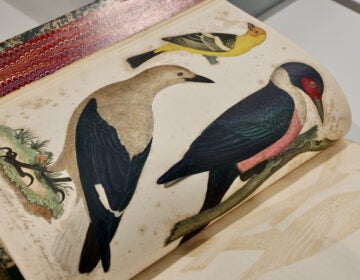Help wanted: Asteroid nudging notions needed
ListenNASA crowd-sourcing for ideas on how to bring an asteroid into lunar orbit. Open to companies, universities, non-profits. Intent is to bring back all or part of an asteroid for study in lunar orbit by 2020 as practice for deep space missions. Proposals due May 5th. Get busy! Speaking of crowd-sourcing, a University of Colorado researcher found that trained volunteers do just as well identifying lunar craters as do experts with up to 50 years of experience. The study compared the performance of thousands of CosmoQuest volunteers against that of eight scientists, using pictures taken by NASA’s Lunar Reconnaissance Orbiter Moon looks great this week, especially Sunday night when it’s next to Jupiter.
March 31, 2014
[Dave Heller] NASA’s looking for a few good ideas regarding ways to snag an asteroid. Let’s cast our nets with Derrick Pitts, chief astronomer at the Franklin Institute. Derrick, what’s the idea here?
[Derrick Pitts] Well the idea is to try to see if there are ideas spread somewhere else outside of NASA’s typical talent pool for how to snag an asteroid and bring it back to lunar orbit sometime before 2020.
Why is the notion predicated on, hey, the average Joe and Jill can do it just as well as our trained staff?
Well, it’s not quite the average Joe or Jill. Even though this opportunity is open to universities, companies, other non-profits and even open to foreign applicants, they’re still looking for a very, very specific kind of knowledge base and skill set. And so that does limit it to not just any Joe, but the idea is that NASA’s thinking that there’s probably plenty more talent out around the world than just within their operational sphere.
Now at this juncture is NASA looking for out-of-the-box ideas, or is it merely refinements on established protocol for capturing an asteroid?
Well, they’re actually looking for both. They’re looking for out-of-the-box ideas and they’re looking for refinements also. The call for proposals is due on May 5, and you can find more information at NASA’s website about this. And maybe you’ve had some ideas that have been brewing around in your basement of how to snag an asteroid!
Now clearly this is a first: We haven’t captured an asteroid and brought it to lunar orbit before.
Yes, that’s quite true — we haven’t done anything like this. It’s a totally out of this world, shall we say, idea for how to begin to train astronauts. How to build up our knowledge base and skill set for deep space manned exploration. And that’s the concept here, is to try to get us some chops for how to do that.
Sounds kinda like crowd sourcing.
Well, you know, in a way you could say that it’s crowd sourcing, although not necessarily crowd sourcing in the normal way of crowd sourcing where you simply throw the opportunities open to anybody in the public. This really is more like a focused kind of crowd sourcing, but it is the idea of NASA reaching outside its in house talent pool. And I think that’s the best thing about this is that NASA isn’t just restricting itself to what it has onboard, but the idea that the mission or the accomplishment of this is so important they’re willing to look anywhere they can to find the talent that can bring the ideas they’re looking for.
-
NASA’s Asteroid Grand Challenge
Plenty of precedent for this concept, including a project looking for craters on the moon.
Yes indeed. A researcher at the University of Colorado did a study of trained volunteers versus experts with 5 to 50 years experience at identifying and counting craters from lunar reconnaissance orbiter photographs, so it’s a recent orbiting mission. And what the researcher did was worked with a group of trained volunteers in program called Cosmoquest. Cosmoquest is a sort of crowd sourced, or citizen science, public science venture to identify and count craters on the moon. And in the past, trained volunteers were just as good as experts at this that have up to 50 years experience at counting craters on the moon.
-
CosmoQuest Moon Mappers – Simply Craters Tutorial
Let’s talk about craters on the moon. How young are the most recent ones?
The most recent naturally-made crater occurred just last year, last fall in fact. And the most recent artificial or man-made crater also took place last year. Now, be it the manmade crater probably wasn’t very big and the natural one was probably bigger, but these things point out to us — especially the natural ones, the naturally made ones — point out the fact that the solar system is still under construction, we can say, because space material still crashes onto the surface of the moon. In fact there was a crash last year just bright enough that it could be seen in videos taken of the moon by amateur observers.
How long ago did the moon endure the assault that created the larger craters?
Very early in the history of the solar system. When most of the solar system was still under construction, but after the formation of the moon as it orbited Earth, it essentially, along with the large planets of our solar system, shielded the Earth from an incredible bombardment that we see as the record of craters on the surface of the moon. Just think: All of those craters that we see on the surface of the moon — the large ones and the small ones — might have been objects that would have impacted the Earth. And that could have had a very devastating effect on the Earth back in its early history, maybe even changing the course of the development of life here on this planet. So we can’t discount the value of the moon and what it has done to protect the Earth, and we see that in the record of the craters on the moon now.
“We can’t discount the value of the moon and what it has done to protect the Earth, and we see that in the record of the craters on the moon now.”
Derrick Pitts
-

Moon craters (AP Photo/NASA)
On a nice night when we look overhead at the moon and we see the Man in the Moon, are we looking at huge individual craters, or clusters that create that face shape?
Well, it’s a great question. We’re looking at clusters of craters that actually make the shape. It’s a combination of a number of things; it’s a combination of the really enormous craters that we recognize as these regions called seas or mauria. And what we’re looking at in that case, is we’re looking at a place where a very large object crashed down onto the surface of the moon, essentially melted right through the crust and then filled the crater left over with molten material from the interior of the moon and from the object that crashed onto the surface of the moon. And you see large ones of these but you also see smaller ones. And if you look really closely with a pair of binoculars, you can easily see subsequent craters. And sometimes they pile right on top of each other. So the features that we see are caused by craters adjacent to each other that occurred at different times.
Is the moon big and bright this week?
The moon is gorgeous this week. In fact, it’s a great week to watch the moon as it rises out of the west after sunset. Day by day it passes through the winter circle of stars, and on Sunday evening of this week, you’ll see it not that far from the brilliant planet Jupiter. And as you continue to watch it through the rest of next week, you’ll be able to see it passing through other stars and constellations. But it looks great particularly on Sunday night next to Jupiter.
WHYY is your source for fact-based, in-depth journalism and information. As a nonprofit organization, we rely on financial support from readers like you. Please give today.




